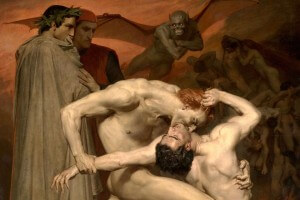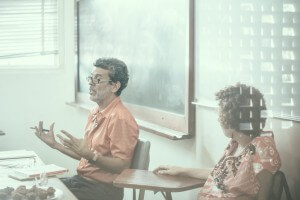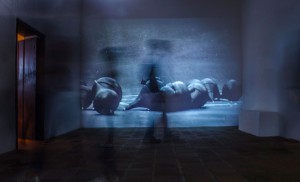The class begins with Natasha Tiniacos speaking from the bareness of Agamben. She introduces the reading and raises the notion of the contemporary: Backroom Caracas’s perspective: a point of view that, despite bifurcating the gaze—for in the contemporary rests “the broken back of time” (Agamben)—, encourages it by irrigating in it an untimely energy. It is a force that disturbs, but it does so in order to release things from their oppressive global standardization and to move them into an analytical and creative stage, where BC is positively constructed as an aesthetic collectivity. BC is an agency, established at the crossroads of the country, inside and outside, front and back, before and after the contingent time that cannot be apprehended except by singling it in capsules or contents that speak to the students immersed in the site. It perhaps says to them: “you must learn how to see” (so reads a phrase that greets us shortly before entering the classroom, written by Miguel Arroyo on the floor of the Faculty of Humanities and Education in an intervention to commemorate its 60th anniversary).
The searches of Backroom Caracas are rooted in that elusive but fertile territory where a team can run without verticalism. Nobody wants to know things for sure; all of them, Rody, Natasha, Florencia, Marianela, Gabriela, Vanessa, and Wilder inquire into the correspondences of profuse elements to aesthetically feed a digital polis. Rody Douzoglou is Greek-Venezuelan and above all cosmopolitan; generosity is her grace, which intuitively opens up new possibilities. That is how Wilder Ríos, the creative producer and architect who strikes a vital element in his analysis, sees it: “BC is not directional”; one works with ambiguity, with spontaneity, enigmatic rhythm, towards fruitful areas of visual and textual links that amaze and profanely enlighten us. Wilder knew that the functionality of architecture would give him tools to deploy in the diffuse realm of conceptual art; thus it extends to new forms of collective writing that we, readers, users, students, are seduced by, kidnapped from the present obstruction—the Caracas of today—towards new contingencies: possible archives. Professor Natasha Tiniacos asks, along with the class (she is diluted between the class and BC, she has ventured away with us): What is appealing about Backroom Caracas? We asked this question to Rody and Natasha when the experience began. It seems that a concern about the appeal of the platform is in the historical a priori of our archiving experience. There is no disciplinary inquiry, as Wilder indicates, but we are exploring urban imaginaries, scenarios, citizen points of view, sketches of social insights (with the vocabulary of Armando Silva). We are speaking about the capital that BC circulates amidst us and that we are now making too.
However, Florencia holds a key answer: the appeal is about visual communication. Florencia, the art director, is on the podium showing us the machine we do not see, from where they program. They tell us about the migration of BC: a new page has just been inaugurated and Florencia Alvarado exposes the process. There was a study, a discussion among them. Thus, within the hermeticism that shelters and sustains what they exhibit, there is knowledge about the digital image: balance, rhythm, form, and theme. Everything comes together with the specific conditions from which they are defined: BC is a Venezuelan art gallery. In the room sits Max Provenzano, a performance artist who inaugurates a new section called Portfolio. Florencia analyzes his oeuvre with punctuality: shots, framing, image distortion by means of the intervening performance, directed action. Many of us are listening to a designer speak about the components of an image for the first time.
In addition, Vanessa Arteaga and Marianela Díaz Cardozo unveil the issue of networks: the formation of social networks, dissemination, and re-diffusion, reaching audiences that may not be so local. And so another question arises: how does the research that we propose at the School of Literature go along with cybernetic writing? That is: how does Backroom Caracas, as micropolitics, as a projection of archives of future cities, communities and visual identities that converge in the critical dissent of contemporary art, join with digital formats?
It is necessary to “air the room,” to ventilate it, says Marianela: a gallery is a contingency, and one must configure it through reflection, acknowledging the various methods and strategies of the platform’s collaborators. BC takes care of its authors and so takes care of its content. Gabriela Mesones Rojo expresses it: there is an ongoing search for artists, writers, and personalities. In addition, the obligation to dust off the thesis format prevails—sometimes, in order to fight against the archive fever that erases initiative. To de-academicize, says Gabriela, to move towards dialogue. And that is where we meet, in dialogue with and from BC, while protected by columns, walls, and ceilings, luminous and rhythmic—the civic scale of the urban tropic that Carlos Raúl Villanueva left us.













